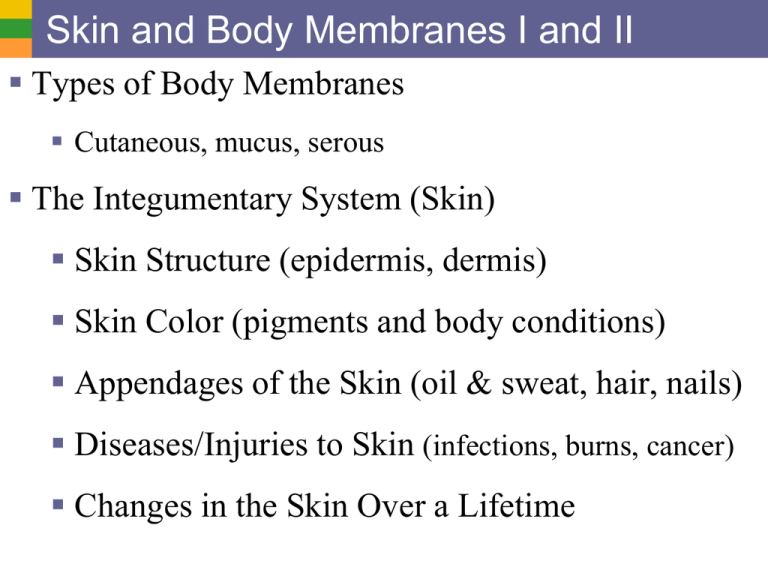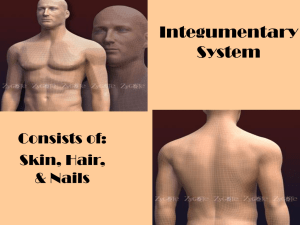Skin and Body Membranes I and II
advertisement

Skin and Body Membranes I and II Types of Body Membranes Cutaneous, mucus, serous The Integumentary System (Skin) Skin Structure (epidermis, dermis) Skin Color (pigments and body conditions) Appendages of the Skin (oil & sweat, hair, nails) Diseases/Injuries to Skin (infections, burns, cancer) Changes in the Skin Over a Lifetime Mucous Membranes: Prone to Dessication Found lining the inside edges of organs or tracts that empty into the exterior of the body Also: Urethra Vaginal tract Digestive tract, anus Nostrils Serous Membranes- Thin linings of organs and body wall • Parietal serosae line internal body walls • Visceral serosae cover internal organs Connective Tissue Membrane Synovial membrane Cutaneous Membrane Functions of the Integumentary System 1. Protection (chemical, physical, biological) 2. Body temperature regulation ( perspiration, dermal vessels) 3. Cutaneous sensations (temperature, touch, and pain) 4. Metabolic functions (synthesis of vitamin D precursor and collagenase; chemical conversion of carcinogens and some hormones 5. Blood reservoir—up to 5% of body’s blood volume 6. Excretion—nitrogenous wastes and salt in sweat Skin Structure Epidermis Keratinized stratified squamous epithelium Cells of epidermis Keratinocytes—produce fibrous protein keratin Melanocytes 10–25% of cells in lower epidermis Produce brown pigment melanin Epidermal dendritic (Langerhans) cells— macrophages that help activate immune system Tactile (Merkel) cells—touch receptors Detail of Epidermal Skin Structure Keratinocytes Stratum corneum 20-30 layers of dead keratinized cells; glycolipids in interstitial spaces. Stratum lucidum Very thin layer of dead, translucent keratinocytes; only palms, soles of feet Stratum granulosum Three to five layers of flattened cells,organelles deteriorating; cytoplasm full of released lipids Stratum spinosum Several layers of keratinocytes unified by desmosomes. Stratum basale one row of actively mitotic stem cells; melanocytes and epidermal dendritic cells. Desmosomes Mnemonic: Basically, the spinning by granny is loose and corny. Melanin granule Melanocyte Dermis Sensory nerve ending Tactile (Merkel) cell Epidermal dendritic cell Dermis Strong, flexible connective tissue Cells include fibroblasts, macrophages, and occasionally mast cells and white blood cells Two layers: Papillary Reticular Skin Structure Hair shaft Epidermis Papillary layer Dermis Reticular layer Hypodermis (superficial fascia) Nervous structures • Sensory nerve fiber • Pacinian corpuscle • Hair follicle receptor (root hair plexus) Dermal papillae Subpapillary vascular plexus Pore Appendages of skin • Eccrine sweat gland • Arrector pili muscle • Sebaceous (oil) gland • Hair follicle • Hair root Cutaneous vascular plexus Adipose tissue Figure 5.1 Layers of the Dermis: Papillary Layer Papillary layer Areolar connective tissue with collagen and elastic fibers and blood vessels Dermal papillae contain: Capillary loops Meissner’s corpuscles (touch se0nsing) Free nerve endings .1 Layers of the Dermis: Reticular Layer Reticular layer ~80% of the thickness of dermis Collagen fibers provide strength and resiliency Elastic fibers provide stretch-recoil properties Pacinian corpuscles (pressure and vibration sensing) Normal Skin Color Determinants Chemicals in the Skin Melanin Carotene Hemoglobin Body Conditions Erythmea (from embarrassment, fever, tension) Pallor/Blanching (stress, etc.) Jaundice from liver disease Bruises from hematomas Cyanosis from low blood oxygen Appendages of the Skin Derivatives of the epidermis Sweat glands Oil glands Hairs and hair follicles Nails Cutaneous Glands: Sebaceous & Sweat Eccrine (Merocrine) Sweat Glands water salts Sebaceous glands (holocrine) Sebum - fragmented cells - fatty acids - Low pH (antibacterial) vitamin C metabolic wastes ammonia urea uric acid lactic acid Apocrine sweat glands confined to axillary and genital areas - Sebum: sweat + fatty substances and proteins -Ducts connect to hair follicles -Functional from puberty onward (as sexual scent glands?) Specialized apocrine include - Ceruminous glands - Mammary glands Appendages of the Skin: Hair Hair and Hair Follicles Appendages of the Skin: Hair Hair follicle and arrector pili muscle Appendages of the Skin: Nails Finger Nail and Nail Bed (Eponychium) Abnormal or Injured Skin Conditions Infections and Allergies of the Skin Athletes foot (caused by tinea pedia fungus) Boils and carbuncles (caused by inflammation and/or bacterial infection of oil glands or follicles Cold sores (caused by viruses like Herpes) Contact dermatitis (caused by allergic reaction) Impetigo (caused by staph bacteria) Psoriasis (scaly skin caused by overproduction and of cells) Burns Heat, electricity, radiation, certain chemicals Burn (tissue damage, denatured protein, cell death) Immediate threat: Dehydration and electrolyte imbalance, leading to renal shutdown and circulatory shock Abnormal or Injured Skin Conditions The Rule of Nines for Estimating Burned Surface Area Burns are critical if: • >25% has second-degree • >10% has third-degree • Any of face, hands, or feet with thirddegree Abnormal or Injured Skin Conditions Burns Only epidermis is damaged Skin is red and swollen Second degree burns Epidermis and upper dermis are damaged Third-degree burns Destroys entire skin layer Burn is gray-white or black Full thickness burn Skin is red with blisters Partial thickness burns First-degree burns Abnormal or Injured Skin Conditions Cancers (Cause: UV, freq. irritation) Basal cell carcinoma Least dangerous Most common type Arises from stratum basale Squamous cell carcinoma Arises from stratum spinosum Metastasizes to lymph nodes Early removal allows a good chance of cure Abnormal Conditions: Skin Cancer Types Malignant melanoma Most deadly of skin cancers Cancer of melanocytes Metastasizes rapidly to lymph and blood vessels Detection uses ABCD rule ABCD Rule in Detecting Melanoma Skin Tags (Acrochordons/ Cutaneous Papillomas) Skin tags are benign growths that are not cancerous Skin Changes Over a Lifetime lanugo milia acne dermatitis vernix caseosa aging skin









